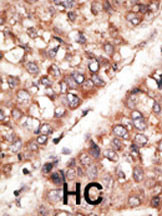Bmp3 Antibody (N-term)
Purified Rabbit Polyclonal Antibody (Pab)
- SPECIFICATION
- CITATIONS
- PROTOCOLS
- BACKGROUND

Application
| IHC-P, WB, E |
|---|---|
| Primary Accession | P12645 |
| Reactivity | Human |
| Host | Rabbit |
| Clonality | Polyclonal |
| Isotype | Rabbit IgG |
| Calculated MW | 53372 Da |
| Antigen Region | 8-36 aa |
| Gene ID | 651 |
|---|---|
| Other Names | Bone morphogenetic protein 3, BMP-3, Bone morphogenetic protein 3A, BMP-3A, Osteogenin, BMP3, BMP3A |
| Target/Specificity | This Bmp3 antibody is generated from rabbits immunized with a KLH conjugated synthetic peptide between 8-36 amino acids from the N-terminal region of human Bmp3. |
| Dilution | IHC-P~~1:50~100 WB~~1:1000 E~~Use at an assay dependent concentration. |
| Format | Purified polyclonal antibody supplied in PBS with 0.09% (W/V) sodium azide. This antibody is prepared by Saturated Ammonium Sulfate (SAS) precipitation followed by dialysis against PBS. |
| Storage | Maintain refrigerated at 2-8°C for up to 2 weeks. For long term storage store at -20°C in small aliquots to prevent freeze-thaw cycles. |
| Precautions | Bmp3 Antibody (N-term) is for research use only and not for use in diagnostic or therapeutic procedures. |
| Name | BMP3 |
|---|---|
| Synonyms | BMP3A |
| Function | Growth factor of the TGF-beta superfamily that plays an essential role in developmental process by inducing and patterning early skeletal formation and by negatively regulating bone density. Antagonizes the ability of certain osteogenic BMPs to induce osteoprogenitor differentiation and ossification (PubMed:11138004, PubMed:15269709). Initiates signaling cascades by associating with type II receptor ACVR2B to activate SMAD2-dependent and SMAD-independent signaling cascades including TAK1 and JNK pathways (PubMed:31665064). |
| Cellular Location | Secreted. |
| Tissue Location | Expressed in adult and fetal cartilage. |

Thousands of laboratories across the world have published research that depended on the performance of antibodies from Abcepta to advance their research. Check out links to articles that cite our products in major peer-reviewed journals, organized by research category.
info@abcepta.com, and receive a free "I Love Antibodies" mug.
Provided below are standard protocols that you may find useful for product applications.
Background
The BMPs belong to the TGF-Beta superfamilyBMPs stimulate the production of bone matrix proteins and thereby alter stromal cell and osteoclast proliferation, a key step in bone marrow development. In addition to promoting ectopic bone and cartilage development, BMPs regulate the growth, differentiation, chemotaxis, proliferation, and apoptosis of various cell types, including mesenchymal cells, epithelial cells, hematopoietic cells, and neuronal cells. BMPs also play a role in dorsal/ventral patterning. BMP3, highly expressed in lung, ovary and small intestine, participates in cartilage and bone formation. BMP3 and BMP2 genes map to conserved regions between human and mouse.
References
Jin, Y., et al., Histol. Histopathol. 16(4):1013-1019 (2001).
Tabas, J.A., et al., Genomics 9(2):283-289 (1991).
Dickinson, M.E., et al., Genomics 6(3):505-520 (1990).
Wozney, J.M., et al., Science 242(4885):1528-1534 (1988).
If you have used an Abcepta product and would like to share how it has performed, please click on the "Submit Review" button and provide the requested information. Our staff will examine and post your review and contact you if needed.
If you have any additional inquiries please email technical services at tech@abcepta.com.













 Foundational characteristics of cancer include proliferation, angiogenesis, migration, evasion of apoptosis, and cellular immortality. Find key markers for these cellular processes and antibodies to detect them.
Foundational characteristics of cancer include proliferation, angiogenesis, migration, evasion of apoptosis, and cellular immortality. Find key markers for these cellular processes and antibodies to detect them. The SUMOplot™ Analysis Program predicts and scores sumoylation sites in your protein. SUMOylation is a post-translational modification involved in various cellular processes, such as nuclear-cytosolic transport, transcriptional regulation, apoptosis, protein stability, response to stress, and progression through the cell cycle.
The SUMOplot™ Analysis Program predicts and scores sumoylation sites in your protein. SUMOylation is a post-translational modification involved in various cellular processes, such as nuclear-cytosolic transport, transcriptional regulation, apoptosis, protein stability, response to stress, and progression through the cell cycle. The Autophagy Receptor Motif Plotter predicts and scores autophagy receptor binding sites in your protein. Identifying proteins connected to this pathway is critical to understanding the role of autophagy in physiological as well as pathological processes such as development, differentiation, neurodegenerative diseases, stress, infection, and cancer.
The Autophagy Receptor Motif Plotter predicts and scores autophagy receptor binding sites in your protein. Identifying proteins connected to this pathway is critical to understanding the role of autophagy in physiological as well as pathological processes such as development, differentiation, neurodegenerative diseases, stress, infection, and cancer.




